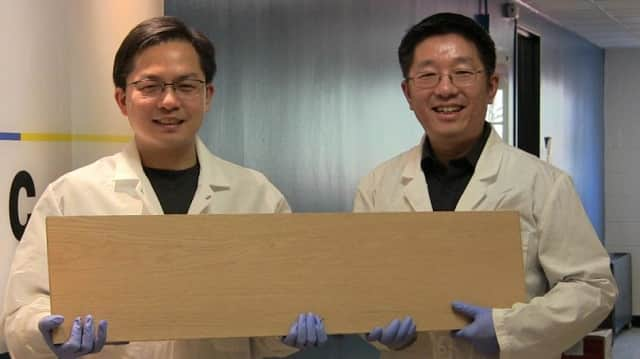
Scientists at the University of Maryland have, through chemical treatments and crushed polymers, found a way to make soft woods over 10 times as strong as their natural form. They’re calling it “super wood.”
Lightweight woods, like pine or balsa, already have a number of common uses in woodworking but they’re just not fit for applications in industrial strength projects. The research team is hopeful that their chemical treatments could change that.
“This new way to treat wood makes it twelve times stronger than natural wood and ten times tougher,” says Liangbing Hu, leader of the research team which published their findings in Nature, in a press statement. “This could be a competitor to steel or even titanium alloys, it is so strong and durable. It’s also comparable to carbon fiber, but much less expensive.”
One of the things that makes wood wood is a polymer known as lignin which forms support structures in trees and plants. The second most abundant naturally-occurring polymer on Earth, lignin is what makes wood rigid and brown. Somewhat counterintuitively, Hu and his team removed the wood’s lignin polymers in order to make their wood even stronger.
The lingin removal allowed the team to compress the wood under a mild heat of around 150 degrees Fahrenheit. Without the lignin binding together the wood’s cells, the scientists were able to make its cellulose fibers very tightly packed.
When the fibers are jammed together, any defects in the wood like knots or holes are crushed. The wood’s fibers begin to form hydrogen bonds, which the scientists compare to “a crowd of people who can’t budge–who are also holding hands.” The compression also shrinks down the size of the wood, making it five times thinner than before it was treated.
The researchers tested the wood’s strength by shooting at it. The fully-treated wood proved its worth by stopping a bullet-like projectile halfway through.
“This kind of wood could be used in cars, airplanes, buildings – any application where steel is used,” Hu says.
There are already plenty of strong woods in the world, like quebracho, snakewood, or African blackwood. Their natural strength makes them difficult to work with and expensive to obtain. The treatment process created by Hu and his team would allow builders to fashion objects using cheap, readily available woods but with the strength of more expensive ones.
“It takes 10 times more energy to fracture than natural wood,” says research team co-leader Teng Li. “It can even be bent and molded at the beginning of the process.”
There’s no word on when and how the Maryland treatment process may become commercially available, but it sure would go a long way to making your DIY lounge chairliterally bulletproof.
